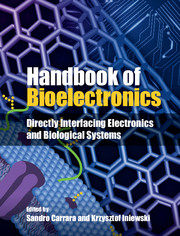Book contents
- Frontmatter
- Contents
- List of Contributors
- 1 What is bioelectronics?
- Part I Electronic components
- Part II Biosensors
- Part III Fuel cells
- Part IV Biomimetic systems
- 18 Biomimetic systems
- 19 Epidermal electronics – flexible electronics for biomedical applications
- 20 Bioelectronics brain using memristive polymer statistical systems
- 21 Electronic modeling of synthetic genetic networks
- Part V Bionics
- Part VI Brain interfaces
- Part VII Lab-on-a-chip
- Part VIII Future perspectives
- Index
- References
18 - Biomimetic systems
from Part IV - Biomimetic systems
Published online by Cambridge University Press: 05 September 2015
- Frontmatter
- Contents
- List of Contributors
- 1 What is bioelectronics?
- Part I Electronic components
- Part II Biosensors
- Part III Fuel cells
- Part IV Biomimetic systems
- 18 Biomimetic systems
- 19 Epidermal electronics – flexible electronics for biomedical applications
- 20 Bioelectronics brain using memristive polymer statistical systems
- 21 Electronic modeling of synthetic genetic networks
- Part V Bionics
- Part VI Brain interfaces
- Part VII Lab-on-a-chip
- Part VIII Future perspectives
- Index
- References
Summary
The concept of biomimetic systems was introduced in the early definition ofbioelectronics. As we have already seen in the first chapter, the originaldefinition of bioelectronics set by Wolfgang Göpel includes“structures [that] may consist… of chemicallysynthesized units such as molecules, supramolecules andbiologically active (biomimetic) recognition centers” [1]. Over theyears, the concept has been expanded in order to move from simplerecognition systems to biomimetic membranes for voltage shifts ingraphene-based transistors [2], systems for cell separation in the blood[3], electronic noses [4, 5], electronic tongues [6], smart info-chemicalcommunication systems [7], electronic design [8], pancreatic beta-cells [9],and neurons [10].
Artificial brain architectures, with all the neurons fully interconnected inparallel, show issues in terms of scalability, especially because the numberof interconnections scales exponentially with the number of neurons [11],while it would be desirable for it to scale like biologically plausiblearchitectures [11]. This brings us to the concept of bio-inspired orbiomimetic systems as possible solutions to solve problems emerging inextremely complex bioelectronics architectures. Over the years, severalbio-inspired and neuromorphic architectures have been proposed in theliterature for silicon neurons [10], synaptic and neural components made ofNiTi [12, 13], sensors [14], orientation tuning devices [15], and patternrecognition systems [16]. In the direction of more complexity andfunctionality, the present state-of-the-art in the field proposes artificialsystems for pancreas [9], skin [17, 18], cognitive architectures, and brains[19, 20].
Information
- Type
- Chapter
- Information
- Handbook of BioelectronicsDirectly Interfacing Electronics and Biological Systems, pp. 241 - 244Publisher: Cambridge University PressPrint publication year: 2015
